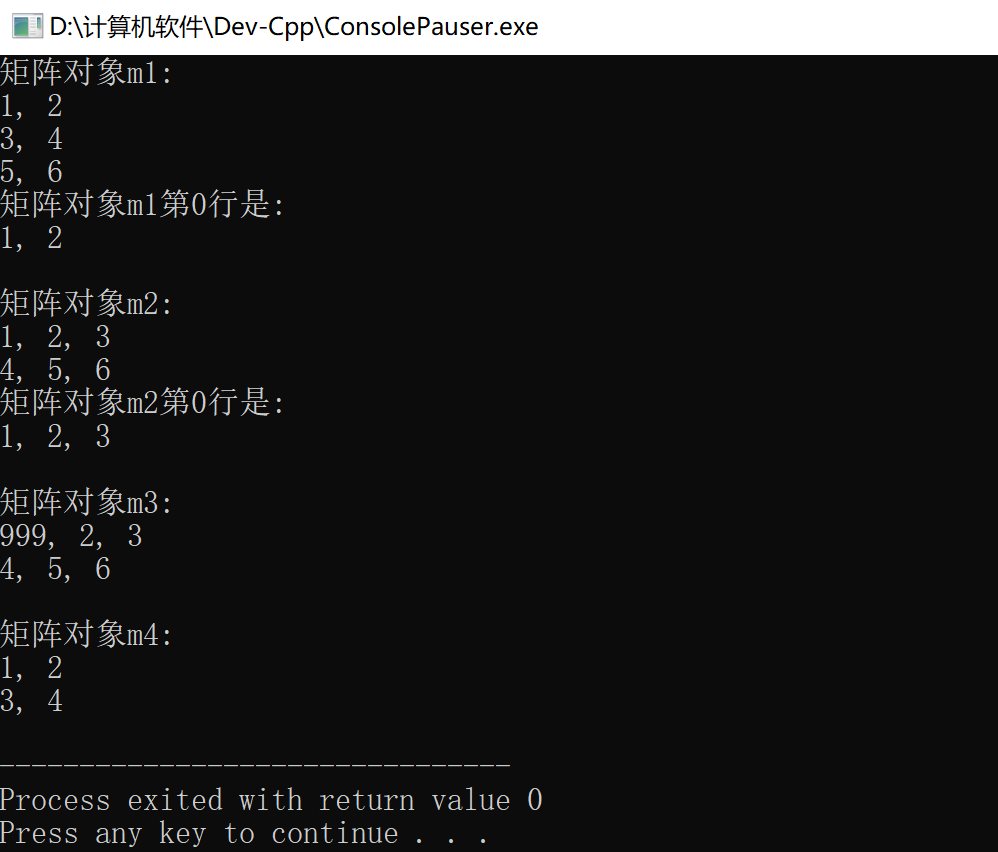任务1:
1.代码:
point.hpp:

1 #pragma once 2 3 #include <iostream> 4 using std::cout; 5 using std::endl; 6 class Point { 7 public: 8 Point(int x0 = 0, int y0 = 0); 9 ~Point() = default; 10 int get_x() const; 11 int get_y() const; 12 void show() const; 13 void move(int new_x, int new_y); 14 private: 15 int x, y; 16 }; 17 Point::Point(int x0, int y0): x{x0}, y{y0} { 18 } 19 int Point::get_x() const { 20 return x; 21 } 22 int Point::get_y() const { 23 return y; 24 } 25 void Point::show() const { 26 cout << "(" << x << ", " << y << ")" << endl; 27 } 28 void Point::move(int new_x, int new_y) { 29 x = new_x; 30 y = new_y; 31 }
task1.cpp:

1 #include <iostream> 2 #include "point.hpp" 3 #include <vector> 4 using std::vector; 5 using std::cin; 6 // 输出vector<Point>对象内所有点的坐标 7 void output(const vector<Point> &v) { 8 for(auto &t: v) 9 t.show(); 10 } 11 void test() { 12 int n; 13 cin >> n; 14 vector<Point> x(n); 15 cout << "x对象中所有点坐标信息: " << endl; 16 output(x); 17 vector<Point> y(x); 18 cout << "\nx对象中所有点坐标信息: " << endl; 19 output(y); 20 cout << "\n更新x对象: " << endl; 21 x.at(0).move(30, 50); 22 x.push_back(Point(2, 2)); 23 cout << "\nx对象中所有点坐标信息: " << endl; 24 output(x); 25 cout << "\ny对象中所有点坐标信息: " << endl; 26 output(y); 27 } 28 int main() { 29 test(); 30 }
2.图片: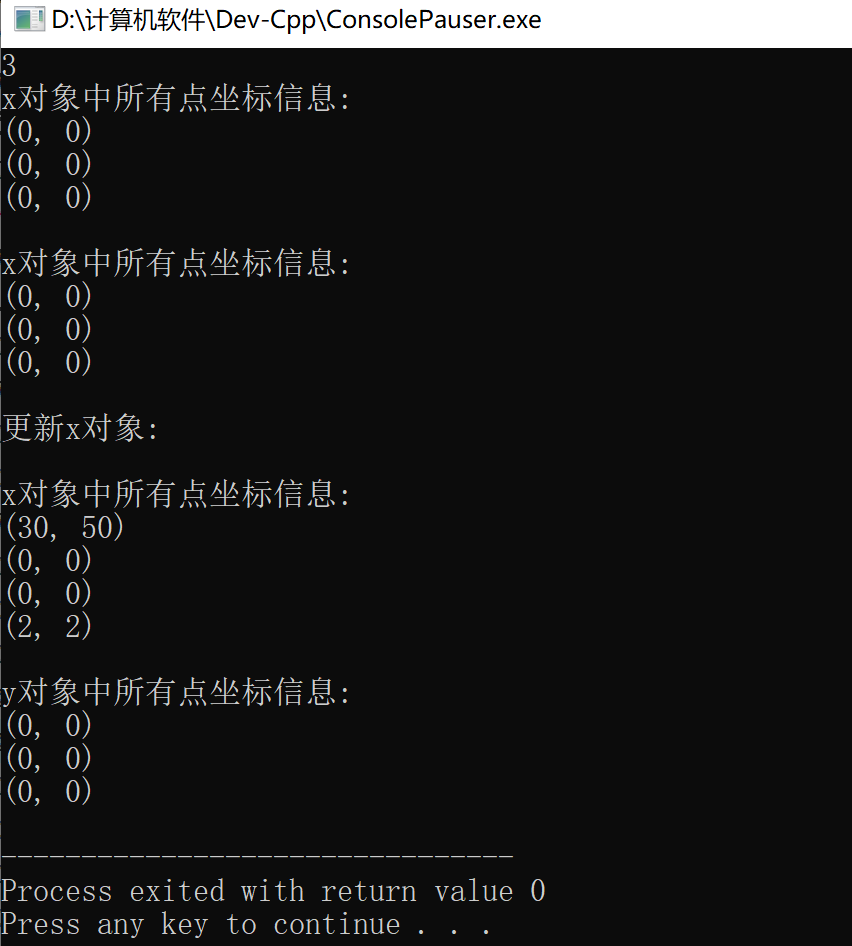
对x对象进行更新时,基于 vector 对象x创建的对象y不发生变化。
标准库模板类vector在复制一个动态数组对象时,实现的是深复制。
任务2:
1.代码:
point.hpp:

1 #pragma once 2 3 #include <iostream> 4 using std::cout; 5 using std::endl; 6 class Point { 7 public: 8 Point(int x0 = 0, int y0 = 0); 9 ~Point() = default; 10 int get_x() const; 11 int get_y() const; 12 void show() const; 13 void move(int new_x, int new_y); 14 private: 15 int x, y; 16 }; 17 Point::Point(int x0, int y0): x{x0}, y{y0} { 18 } 19 int Point::get_x() const { 20 return x; 21 } 22 int Point::get_y() const { 23 return y; 24 } 25 void Point::show() const { 26 cout << "(" << x << ", " << y << ")" << endl; 27 } 28 void Point::move(int new_x, int new_y) { 29 x = new_x; 30 y = new_y; 31 }
vectorpoint.hpp:

1 #pragma once 2 #include "point.hpp" 3 #include <cassert> 4 #include <iostream> 5 class vectorPoint{ 6 public: 7 vectorPoint(int n); 8 ~vectorPoint(); 9 10 int get_size() const; 11 Point &at(int index); 12 Point& at(int index) const; 13 14 private: 15 int size; 16 Point* ptr; 17 }; 18 19 vectorPoint::vectorPoint(int n):size{n} 20 { 21 ptr=new Point[n]; 22 } 23 24 vectorPoint::~vectorPoint() { 25 delete[] ptr; 26 } 27 int vectorPoint::get_size() const { 28 return size; 29 } 30 Point& vectorPoint:: at(int index){ 31 assert(index >= 0 && index < size); 32 33 return ptr[index]; 34 } 35 Point& vectorPoint::at(int index) const { 36 assert(index >= 0 && index < size); 37 return ptr[index]; 38 }
task2.cpp:

1 #include "vectorPoint.hpp" 2 #include <iostream> 3 4 void output(const vectorPoint &v) { 5 for(auto i = 0; i < v.get_size(); ++i) 6 v.at(i).show(); 7 } 8 9 void test() { 10 using namespace std; 11 int n; 12 cout << "输入vectorPoint对象中元素个数: "; 13 cin >> n; 14 vectorPoint x(n); 15 cout << "x对象中所有点坐标信息: " << endl; 16 output(x); 17 vectorPoint y(x); 18 cout << "\ny对象中所有点坐标信息: " << endl; 19 output(y); 20 cout << "\n更新x对象中点坐标信息......" << endl; 21 x.at(0).move(30, 50); 22 x.at(1).move(-1, -1); 23 cout << "x对象中所有点坐标信息: " << endl; 24 output(x); 25 cout << "\ny对象中所有点坐标信息: " << endl; 26 output(y); 27 } 28 int main() { 29 test(); 30 }
2.图片:
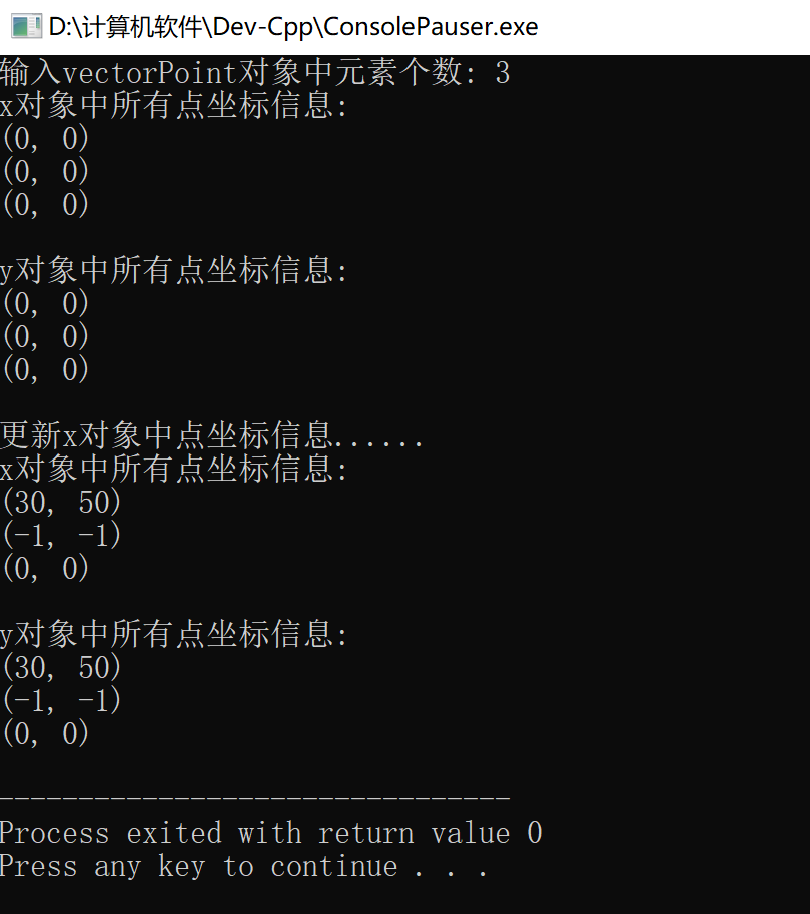
更新对象x后,基于 vectorPoint 对象x创建的对象y发生变化。
编译器为vectorPoint类创建的默认复制构造函数,在复制一个动态数组对象时,实现是浅复制。
在类vectorPoint内部,手动增加的以下复制构造函数声明和定义,实现的是是浅复制。
任务3:
1.代码:
point,hpp:

1 #pragma once 2 #include <iostream> 3 using std::cout; 4 using std::endl; 5 class Point { 6 public: 7 Point(int x0 = 0, int y0 = 0); 8 ~Point() = default; 9 int get_x() const; 10 int get_y() const; 11 void show() const; 12 void move(int new_x, int new_y); 13 private: 14 int x, y; 15 }; 16 Point::Point(int x0, int y0): x{x0}, y{y0} { 17 } 18 int Point::get_x() const { 19 return x; 20 } 21 int Point::get_y() const { 22 return y; 23 } 24 void Point::show() const { 25 cout << "(" << x << ", " << y << ")" << endl; 26 } 27 void Point::move(int new_x, int new_y) { 28 x = new_x; 29 y = new_y; 30 }
vectorpoint.hpp:

1 #pragma once 2 #include "point.hpp" 3 #include <cassert> 4 #include <iostream> 5 class vectorPoint{ 6 public: 7 vectorPoint(int n); 8 vectorPoint(const vectorPoint &vp); 9 ~vectorPoint(); 10 int get_size() const; // 获得当前动态数组内元素个数 11 Point& at(int index); // 返回下标为index的元素引用 12 Point& at(int index) const; // 返回下标为index的元素const引用 13 private: 14 int size; // 动态数组的大小 15 Point *ptr; 16 }; 17 vectorPoint::vectorPoint(int n) : size{n} { 18 ptr = new Point[n]; 19 } 20 vectorPoint::vectorPoint(const vectorPoint &vp): size{vp.size}, ptr{new 21 Point[size]} { 22 for(auto i = 0; i < size; ++i) 23 ptr[i] = vp.ptr[i]; 24 } 25 vectorPoint::~vectorPoint() { 26 delete[] ptr; 27 } 28 int vectorPoint::get_size() const { 29 return size; 30 } 31 Point& vectorPoint::at(int index) { 32 assert(index >= 0 && index < size); // 宏,在测试模式下工作。如果不满足条件,则程序终止 33 34 return ptr[index]; 35 } 36 Point& vectorPoint::at(int index) const { 37 assert(index >= 0 && index < size); 38 return ptr[index]; 39 }
task3.cpp:

1 #include "vectorPoint.hpp" 2 #include <iostream> 3 // 输出vectorPoint对象内的所有数据 4 void output(const vectorPoint &v) { 5 for(auto i = 0; i < v.get_size(); ++i) 6 v.at(i).show(); 7 } 8 // 测试vectorPoint类:构造对象、复制构造对象 9 void test() { 10 using namespace std; 11 int n; 12 cout << "输入vectorPoint对象中元素个数: "; 13 cin >> n; 14 vectorPoint x(n); 15 cout << "x对象中所有点坐标信息: " << endl; 16 output(x); 17 vectorPoint y(x); 18 cout << "\ny对象中所有点坐标信息: " << endl; 19 output(y); 20 cout << "\n更新x对象中点坐标信息......" << endl; 21 x.at(0).move(30, 50); 22 x.at(1).move(-1, -1); 23 cout << "x对象中所有点坐标信息: " << endl; 24 output(x); 25 cout << "\ny对象中所有点坐标信息: " << endl; 26 output(y); 27 } 28 int main() { 29 test(); 30 }
2.图片:

更新对象x后,基于 vectorPoint 对象x创建的对象y不发生变化。
这个vectorPoint 类的实现中,复制构造函数实现的是深复制。
深复制时重新为一个节点分配空间,并将数值复制过去,两个指向的是不同地址;浅复制两个指针指向的是同一个地址。
任务4:
task1.cpp:

1 #include <iostream> 2 using namespace std; 3 // 函数声明 4 void swap1(int &rx, int &ry); // 引用作为形参 5 void swap2(int *px, int *py); // 指针作为形参 6 void print(int x, int y); // 普通变量作为形参 7 // 测试代码 8 void test() { 9 int x = 3, y = 4; 10 print(x, y); 11 swap1(x, y); // 函数调用,注意:引用作为形参时,实参形式 12 print(x, y); 13 cout << endl; 14 x = 3, y = 4; 15 print(x, y); 16 swap2(&x, &y); // 函数调用,注意:指针作为形参时,实参形式 17 print(x, y); 18 } 19 int main() { 20 test(); 21 } 22 // 函数定义:交换两个变量(引用变量作为形参) 23 void swap1(int &rx, int &ry) { 24 int t; 25 t = rx; rx = ry; ry = t; 26 } 27 // 函数定义:交换两个变量(指针变量作为形参) 28 void swap2(int *px, int *py) { 29 int t; 30 t = *px; *px = *py; *py = t; 31 } 32 // 函数定义:输出两个变量(普通变量作为形参) 33 void print(int x, int y) { 34 std::cout << "x = " << x << ", y = " << y << "\n"; 35 }
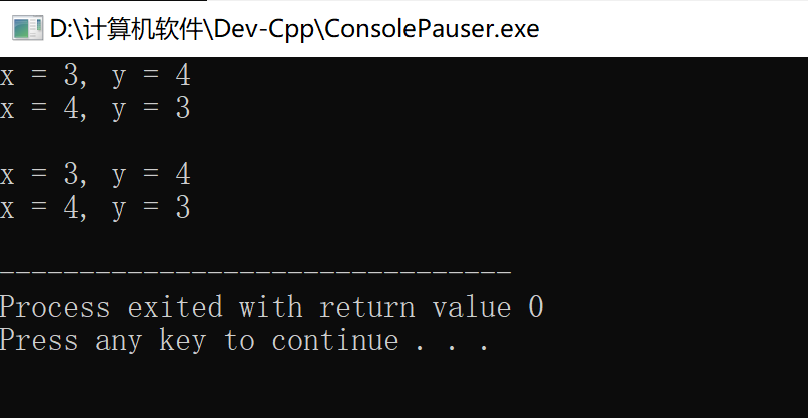
task2.cpp:

1 #include <iostream> 2 #include <typeinfo> 3 using namespace std; 4 int main() { 5 int a; 6 int &ra = a; 7 ra = 4; 8 int *pa = &a; 9 *pa = 5; 10 // 以十六进制形式输出普通变量a, 引用变量ra,指针变量pa的地址 11 cout << "&a = " << hex << &a << endl; 12 cout << "&ra = " << hex << &ra << endl; 13 cout << "&pa = " << hex << &pa << "\n\n"; 14 // 输出普通变量a, 引用变量ra,指针变量pa的值 15 cout << "a = " << a << endl; 16 cout << "ra = " << a << endl; 17 cout << "pa = " << hex << pa << endl; 18 // 输出指针变量pa指向的变量的值 19 cout << "*pa = " << *pa << "\n\n"; 20 // 输出普通变量a,引用变量ra, 指针变量pa的类型信息 21 cout << "type a: " << typeid(a).name() << endl; 22 cout << "type ra: " << typeid(ra).name() << endl; 23 cout << "type pa: " << typeid(pa).name() << endl; 24 }
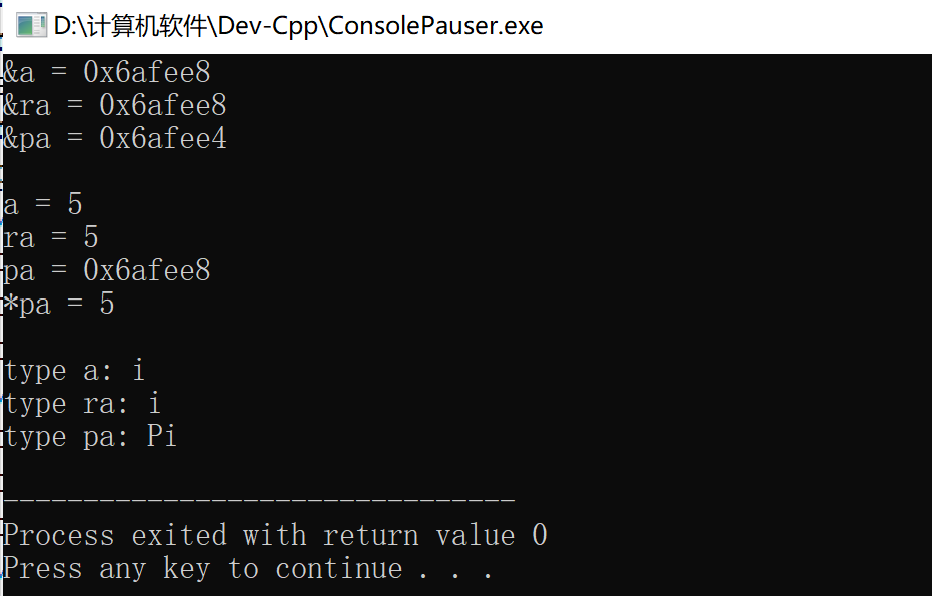
task3.cpp:

1 #include <iostream> 2 #include <vector> 3 using namespace std; 4 template<typename T> 5 void output(const T &x) { 6 for(auto i: x) 7 std::cout << i << ", "; 8 std::cout << "\b\b \n"; 9 } 10 template<typename T> 11 void square1(T &x) { 12 for(auto i: x) // i是普通类型 13 i *= i; 14 } 15 template<typename T> 16 void square2(T &x) { 17 for(auto &i: x) // i是引用类型 18 i *= i; 19 } 20 void test1() { 21 vector<int> x {1, 2, 3, 4, 5}; 22 cout << "动态int型数组对象x内的元素值: "; 23 output(x); 24 cout << "调用函数square1()......" << endl; 25 square1(x); 26 cout << "动态int型数组对象x内的元素值: "; 27 output(x); 28 } 29 void test2() { 30 vector<int> x {1, 2, 3, 4, 5}; 31 cout << "动态int型数组对象x内的元素值: "; 32 output(x); 33 cout << "调用函数square2()......" << endl; 34 square2(x); 35 cout << "动态int型数组对象x内的元素值: "; 36 output(x); 37 } 38 int main() { 39 cout << "测试1: " << endl; 40 test1(); 41 cout << "\n测试2: " << endl; 42 test2(); 43 }

1.在C++中,引用在声明时必须被初始化,并且一旦一个引用被绑定到一个对象,就不能再被重新绑定到另一个对象。引用总是代表同一个对象。另一方面,指针可以在任何时候被重新指向 另一个对象,或者被设为nullptr。所以引用与对象是同一个地址,指针则不是。
2.引用是直接引用的,即引用的对象可以直接访问。指针则是间接引用的,如果想要访问指针指向的对象需要用"*"符号。
3.函数中不使用引用或者指针的话原本的对象的数值是不会改变的。
任务5:
1.代码:
vectorInt.hpp:

1 #pragma once 2 #include<cassert> 3 #include<iostream> 4 5 class vectorInt{ 6 public: 7 vectorInt(int n); 8 vectorInt(int n,int value); 9 vectorInt(const vectorInt &vp); 10 ~vectorInt(); 11 12 int get_size()const; 13 int& at(int index); 14 int& at(int index)const; 15 void show()const; 16 17 private: 18 int size; 19 int* ptr; 20 21 }; 22 23 vectorInt::vectorInt(int n):size{n}{ 24 ptr=new int[n]; 25 std::cout << "constructor vectorInt(int n) called. \n"; 26 } 27 28 vectorInt::vectorInt(int n,int value):size{n}{ 29 ptr=new int[n]; 30 for(int i=0;i<n;i++) 31 { 32 ptr[i]=value; 33 } 34 std::cout << "constructor vectorInt(int n, int value) called. \n"; 35 } 36 37 vectorInt::vectorInt(const vectorInt &vp):size{vp.size},ptr{new int[size]} 38 { 39 for(auto i = 0; i < size; ++i) 40 ptr[i] = vp.ptr[i]; 41 std::cout << "copy constructor called. \n"; 42 } 43 44 vectorInt::~vectorInt() { 45 delete[] ptr; 46 std::cout << "destructor called" << std::endl; 47 } 48 49 int vectorInt::get_size() const { 50 return size; 51 } 52 53 int& vectorInt::at(int index) 54 { 55 return ptr[index]; 56 } 57 int& vectorInt::at(int index)const 58 { 59 return ptr[index]; 60 }
task5.cpp:

1 #include "vectorInt.hpp" 2 #include <iostream> 3 using std::cout; 4 using std::cin; 5 using std::endl; 6 // 函数output()的定义:遍历输出vectorInt对象内的所有元素 7 void output(const vectorInt &vi) { 8 for(auto i = 0; i < vi.get_size(); ++i) 9 cout<<vi.at(i)<<", "; 10 cout<<"\b\b\n"; 11 12 } 13 void test() { 14 int n; 15 cout << "输入vectorInt对象中元素个数: "; 16 cin >> n; 17 vectorInt x1(n); // 构造动态int数组对象x1,包含n个元素,不对元素初始化 18 for(auto i = 0; i < n; ++i) 19 x1.at(i) = i*i; 20 cout << "vectorInt对象x1: "; 21 output(x1); 22 vectorInt x2(n, 42); // 构造动态int数组对象x1,包含n个元素,每个元素初始值为42 23 cout << "vectorInt对象x2: "; 24 output(x2); 25 vectorInt x3(x2); // 使用x2构造x3 26 cout << "vectorInt对象x3: "; 27 output(x3); 28 cout << "更新vectorInt对象x2......\n"; 29 x2.at(0) = 77; 30 x2.at(1) = -999; 31 cout << "vectorInt对象x2: "; 32 output(x2); 33 cout << "vectorInt对象x3: "; 34 output(x3); 35 } 36 int main() { 37 test(); 38 }
2.图片:
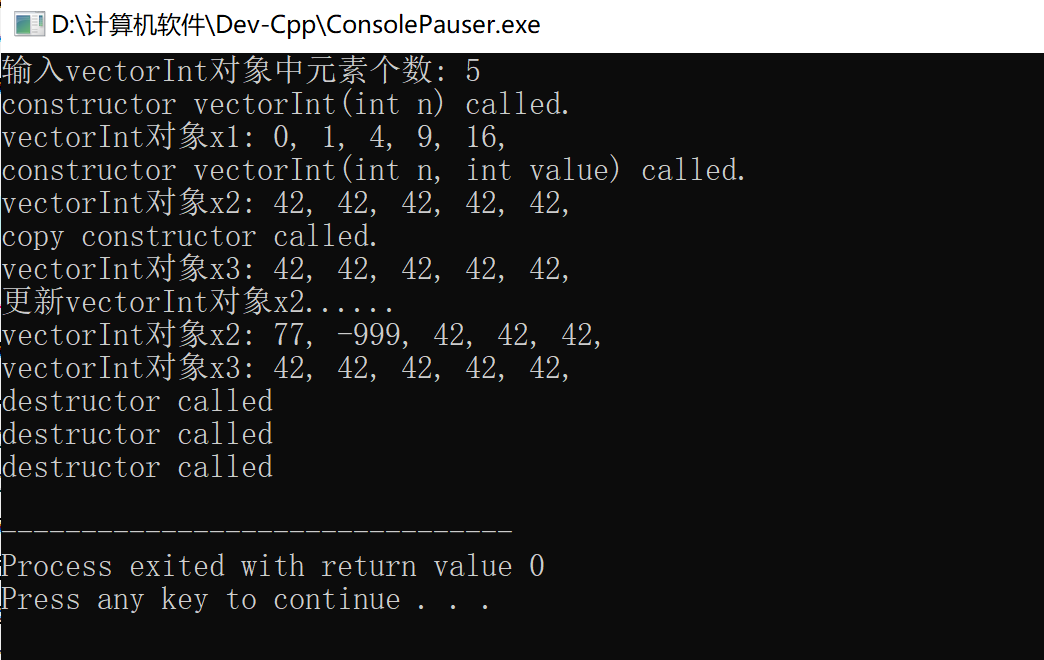
任务6:
1.代码:
matrix.hpp:

1 #pragma once 2 #include <iostream> 3 #include <cassert> 4 using std::cout; 5 using std::endl; 6 // 类Matrix的声明 7 class Matrix { 8 public: 9 Matrix(int n, int m); // 构造函数,构造一个n*m的矩阵 10 Matrix(int n); // 构造函数,构造一个n*n的矩阵 11 Matrix(const Matrix &x); // 复制构造函数, 使用已有的矩阵X构造 12 ~Matrix(); 13 void set(const double *pvalue); // 用pvalue指向的连续内存块数据按行为矩阵赋值 14 15 void set(int i, int j, double value); // 设置矩阵对象索引(i,j)的元素值为value 16 17 double& at(int i, int j) const; // 返回矩阵对象索引(i,j)的元素引用 18 double& at(int i, int j); // 返回矩阵对象索引(i,j)的元素引用 19 int get_lines() const; // 返回矩阵对象行数 20 int get_cols() const; // 返回矩阵对象列数 21 void print() const; // 按行打印输出矩阵对象元素值 22 private: 23 int lines; // 矩阵对象内元素行数 24 int cols; // 矩阵对象内元素列数 25 double *ptr; 26 }; 27 28 Matrix::Matrix(int n, int m):lines{n},cols{m} 29 { 30 ptr=new double[n*m]; 31 } 32 33 Matrix::Matrix(int n):lines{n},cols{n}{ 34 ptr=new double[n*n]; 35 } 36 37 Matrix::Matrix(const Matrix &x):lines{x.lines},cols{x.cols} 38 { 39 ptr=new double[x.lines*x.cols]; 40 for(int i=0;i<lines*cols;i++) 41 { 42 ptr[i]=x.ptr[i]; 43 } 44 } 45 46 Matrix::~Matrix() 47 { 48 delete[] ptr; 49 } 50 51 void Matrix::set(const double *pvalue) 52 { 53 for(int i=0,j=0;i<lines*cols;i++,j++) 54 { 55 ptr[i]=pvalue[j]; 56 } 57 } 58 59 void Matrix::set(int i, int j, double value) 60 { 61 ptr[i*lines+j]=value; 62 } 63 64 double& Matrix::at(int i, int j) const 65 { 66 return ptr[i*lines+j]; 67 } 68 69 double& Matrix::at(int i, int j) 70 { 71 return ptr[i*lines+j]; 72 } 73 74 int Matrix::get_lines() const 75 { 76 return lines; 77 } 78 int Matrix::get_cols() const { 79 80 return cols; 81 } 82 void Matrix::print() const 83 { 84 for(int i=0;i<lines;i++) 85 { 86 for(int j=0;j<cols;j++) 87 { 88 cout<<ptr[i*cols+j]<<", "; 89 } 90 cout<<"\b\b \n"; 91 } 92 93 }
task6.cpp:

1 #include <iostream> 2 #include "matrix.hpp" 3 using namespace std; 4 const int N1 = 3; 5 const int N2 = 2; 6 // 输出一个矩阵对象中索引为index对应的行的所有元素值 7 void output(const Matrix &m, int index) { 8 for(auto j = 0; j < m.get_cols(); ++j) 9 cout << m.at(index, j) << ", "; 10 cout << "\b\b \n"; 11 } 12 void test() { 13 double x[N1*N2] = {1, 2, 3, 4, 5, 6}; 14 Matrix m1(N1, N2); // 创建一个N1×N2矩阵 15 m1.set(x); // 用一维数组x的值按行为矩阵m1赋值 16 cout << "矩阵对象m1: " << endl; 17 m1.print(); // 打印矩阵m1的值 18 cout << "矩阵对象m1第0行是: " << endl; 19 output(m1, 0); 20 cout << endl; 21 Matrix m2(N2, N1); 22 m2.set(x); 23 cout << "矩阵对象m2: " << endl; 24 m2.print(); 25 cout << "矩阵对象m2第0行是: " << endl; 26 output(m2, 0); 27 cout << endl; 28 Matrix m3(m2); // 用矩阵m2构造新的矩阵m3 29 m3.set(0, 0, 999); // 讲矩阵对象m2索引(0,0)元素设为999 30 cout << "矩阵对象m3:" << endl; 31 m3.print(); 32 cout << endl; 33 Matrix m4(2); // 创建一个2*2矩阵对象 34 m4.set(x); // 用一维数组x的值按行为矩阵m4赋值 35 cout << "矩阵对象m4:" << endl; 36 m4.print(); 37 } 38 int main() { 39 test(); 40 }
2.图片:
